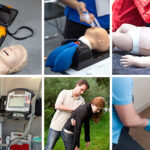Panic attacks may be an overwhelming experience for absolutely everyone. They can strike without warning and cause intense fear and physical damage like heart attacks. While panic attacks are related to panic disease, they can also arise in other anxiety-related problems and are similar to an asthma attack. In this guide we will discuss panic attacks, who can have them, and how to manage them in public and private settings with first aid. We will even discuss methods to help someone with a panic attack, how to encourage the person and the importance of professional assistance.
What is a panic attack?
A panic attack is when you abruptly experience fear, like something horrible will happen to you, or you’ll die. It can strike without caution with signs and symptoms such as troubled breathing, extended heartbeat, and dizziness. With panic attacks, you often get overwhelming emotions of dread or imminent doom. You might also experience panic attacks when anxious or sad.
Who can get a panic attack?
Panic attacks can affect any person, irrespective of age or gender. However, certain risk factors may also make someone more liable to experiencing panic attacks. These include:
- Genetics: Panic ailment and panic attacks can run in families, suggesting a genetic predisposition.
- Major Life Stressors: Significant life modifications or emotionally charged activities, including the death of a loved one, divorce, or financial problems, can cause panic attacks.
- Traumatic Experiences: People who experience physical or emotional trauma are more likely to experience panic attacks.
- Substance Abuse: Use of alcohol and drugs increases the risk of getting a panic attack.
How to stop a panic attack?
Numerous techniques can help someone to stop a panic attack and probably keep it from escalating. Here are some pointers:
- Practice Deep Breathing: Taking gradual, deep and breaths lets you calm the body and thoughts, decreasing the heart rate.
- Use Grounding Techniques: Focus on your environment by way of the use of your senses. Focus on listening, contact, and smell. It can assist in bringing your mind again to the present second.
- Challenge Negative Thoughts: Negative thoughts cause panic attacks, which causes a negative mind. You need to break the cycle and see things in a different way.
- Seek Support: Talk to a therapist or a member of the family about your feelings. Having a person validate your emotions can make subjects lighter inside your head.
Tips for Managing a Panic Attack in Pubic
Handling a panic attack at home differs significantly from one that comes to the forefront in public. While you do want to stay calm and use breathing techniques, you want to do the following:
- Distraction Techniques: Engaging in activities that require focus, such as counting or solving a puzzle, can help shift your attention away from the panic trigger.
- Plan: If situations cause your panic attacks, attempt to stay away from them. Either decide not to visit the location or walk away while things get unbearable.
- Have a Support Person on Site: Try to have someone who knows your mental state and can handle your panic.
- Keep Medicines Close: When moving outside the house, you must constantly have your prescribed drugs on you.
Remember that managing a panic attack in public may be challenging, and being patient with yourself is vital. Seeking expert help can also give you extra support.
How to help someone having a panic attack?
If you see a person displaying signs and symptoms of a panic attack, remain calm and assist them with the following methods:
- Stay Calm: You may feel overwhelmed or scared when seeing a person in distress. However, it is important to encourage the person to stay calm so you can assist them better.
- Ask How You Can Help: Everyone responds to panic attacks differently, so asking the victim what they need comes first. Some may also require you to stay with them, even though others prefer space.
- Encourage Deep Breathing: You can guide the individual to take slow, deep breaths to assist them in regulating their breathing.
- Provide Reassurance: Encourage the person to be positive and assure them that they’re safe. Avoid disregarding their feelings or telling them to calm down.
- Call Help: Call 911 and their family for clinical and emotional help.
Read More: https://cprcare.com/which-life-saving-courses-can-help-mental-health-emergencies/
Conclusion
You should never take a panic attack lightly. It may begin with something as small as misplacing a pen; your whole world comes crumbling down in your head earlier than you realize it. You start doubting your choices, your decisions, and your life. Irrespective of the kind of loss, a panic or anxiety attack needs reassurance and help. You can help people with first aid skills if they take desperate measures and hurt themselves.







